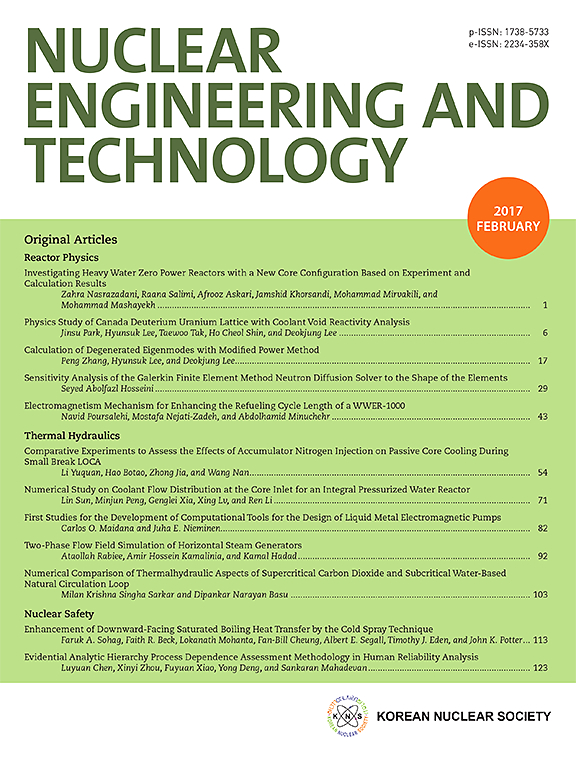Quantitative analysis of impurities in neutron transmutation-doped silicon carbide wafers using neutron activation analysis
IF 2.6
3区 工程技术
Q1 NUCLEAR SCIENCE & TECHNOLOGY
引用次数: 0
Abstract
Neutron transmutation doping (NTD) modifies the electrical properties of semiconductor materials by irradiating them with neutrons to introduce dopants with high uniformity. Although NTD has been widely utilized for Si semiconductors, its application to SiC, a wide-bandgap material well suited for high-power devices, has not yet been thoroughly investigated. Conventional doping approaches for SiC face challenges, such as lattice damage and impurity contamination. In this regard, NTD is a promising alternative because of its ability to introduce dopants uniformly. Therefore, this study aims to investigate the characteristics of NTD-SiC wafers irradiated in a HANARO research reactor, focusing on residual radioactivity and impurity mass evaluation via neutron activation analysis. Three radioisotopes (60Co, 95Zr, and 182Ta) were identified in the NTD-SiC wafers, with 182Ta exhibiting the highest activity of up to 7330 Bq. Impurity analysis revealed significant contributions from 181Ta, with its mass reaching up to 1.37 μg. These findings highlight the importance of controlling tantalum impurities to ensure that NTD-SiC meets the safety standards for residual radioactivity, thereby enabling its reliable application in high-power semiconductor devices.
用中子活化分析法定量分析中子嬗变掺杂碳化硅晶圆中的杂质
中子嬗变掺杂(NTD)是通过中子辐照半导体材料来引入具有高均匀性的掺杂剂,从而改变半导体材料的电学性质。虽然NTD已广泛应用于硅半导体,但其在SiC(一种适合大功率器件的宽带隙材料)上的应用尚未得到深入研究。传统的SiC掺杂方法面临晶格损伤和杂质污染等挑战。在这方面,NTD是一个很有前途的替代方案,因为它能够均匀地引入掺杂剂。因此,本研究旨在研究在HANARO研究堆中辐照的NTD-SiC晶圆的特性,重点研究通过中子活化分析的残余放射性和杂质质量评价。在NTD-SiC晶圆中发现了三种放射性同位素(60Co, 95Zr和182Ta),其中182Ta的活性最高,可达7330 Bq。杂质分析表明181Ta的贡献很大,其质量可达1.37 μg。这些发现强调了控制钽杂质以确保NTD-SiC符合残留放射性安全标准的重要性,从而使其在大功率半导体器件中的可靠应用成为可能。
本文章由计算机程序翻译,如有差异,请以英文原文为准。
求助全文
约1分钟内获得全文
求助全文
来源期刊

Nuclear Engineering and Technology
工程技术-核科学技术
CiteScore
4.80
自引率
7.40%
发文量
431
审稿时长
3.5 months
期刊介绍:
Nuclear Engineering and Technology (NET), an international journal of the Korean Nuclear Society (KNS), publishes peer-reviewed papers on original research, ideas and developments in all areas of the field of nuclear science and technology. NET bimonthly publishes original articles, reviews, and technical notes. The journal is listed in the Science Citation Index Expanded (SCIE) of Thomson Reuters.
NET covers all fields for peaceful utilization of nuclear energy and radiation as follows:
1) Reactor Physics
2) Thermal Hydraulics
3) Nuclear Safety
4) Nuclear I&C
5) Nuclear Physics, Fusion, and Laser Technology
6) Nuclear Fuel Cycle and Radioactive Waste Management
7) Nuclear Fuel and Reactor Materials
8) Radiation Application
9) Radiation Protection
10) Nuclear Structural Analysis and Plant Management & Maintenance
11) Nuclear Policy, Economics, and Human Resource Development
 求助内容:
求助内容: 应助结果提醒方式:
应助结果提醒方式:


